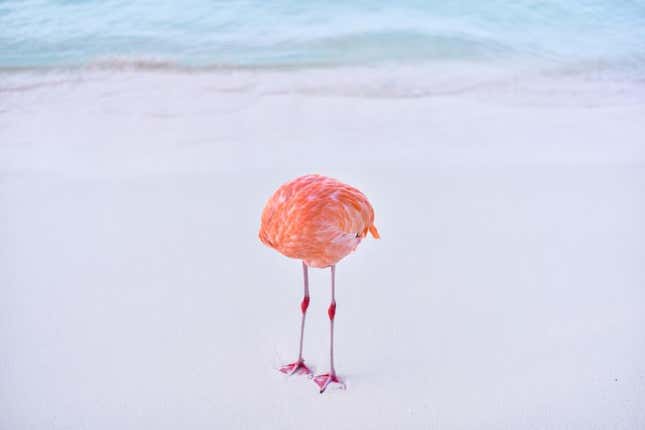In a novel twist of fate, a not-AI photograph masquerading as an AI-produced image won third place in a fine art photography contest in its all-new “AI” category. We’re far more used to hearing about the reverse, where AI bamboozles poor art judges into offering awards for generated images. It’s more than just a footnote to AI’s inevitable takeover. It points to something AI generators can’t do as well as humans: composition.
The awards have since taken down photographer Miles Astray’s not-actually-AI image titled F L A M I N G O N E. Android Authority first picked up on the strange anomaly, hinting that we vastly overestimate AI’s ability to stimulate our senses or that actual photos and art with a human touch are inevitably better than those that don’t.
The photo is of a flamingo seemingly losing its head (relatable). The photo does look like an AI hallucination at a glance. According to Astray, the animal had tucked its head away when he took the picture.

The 1839 award is a relatively new contest formed by the Creative Resource Collective, which aims to offer resources to fine art photographers. In an email statement, co-founder and director of CRC Lily Fierman said, “We fully appreciate the powerful message Miles relayed with his non-AI submission. We agree that it is an important, relevant, and timely statement.”
Still, CRC removed it from the award slate because it did not meet the category criteria and “in consideration of the other artists who submitted their work.” She added that her organization is trying to work with Astray to produce a future blog post on AI in photography.
For his part, Astray said in a release that the whole point was to show real-life art will always win against anything manufactured with a prompt box, saying, “This jab at AI and its ethical implications outweighs the ethical implications of deceiving the viewer, which, of course, is ironic because that is what AI does.”
The photographer had been hinting about the non-AI nature of the photo on his social media accounts and had enlisted his followers to vote for the image, though, of course, that wouldn’t influence the other judges much.
“I’m glad to see that this experiment confirmed my hypothesis,” Astray added. “There is nothing more fantastic and creative than Mother Nature herself.”
Two former runners in the professional photographer’s AI category have replaced the bronze award and the People’s Choice Award. The People’s Choice winner, titled AI Self 2 by portrait artist Josh New, includes the description that he “used Midjourney to describe a photograph I had taken, and then imagined all four of the descriptions, resulting in 16 unique images. I chose this one, photographed myself in the light of the image, and composited myself in.”
Color Correspondence’s new bronze winner claims it was created with a “custom machine learning model.” That’s far from other moving images featured in places like the MoMA. The winning picture with the name Untitled has no description, and it remains unclear if there was anything ostensibly bespoke about it compared to the other two winners.
Judging solely by each image’s descriptions, the two winning photos with less hands-on effort won out over those that included a human touch, whether artistic or technological. The judges for this year’s contest included prominent members of the photo community and from several notable art galleries. It included the likes of New York Times photo manager Aliya Nimmons and senior manager of print sales at Getty Lauren Katz. Gizmodo reached out to several judges for insight on how the process worked, and we will update if we hear anything back.
We’ve had enough time to rub up against AI’s idiosyncrasies. If you look at the earlier examples of AI photos winning actual art contests, it’s pretty apparent they’re AI-generated. The once-winning entry to the Sony World Photography Awards has an unmistakable, plastic-y look and a composition that does not make sense. The Midjourney-generated piece submitted to the Colorado State Fair art competition back in 2022 has all the tell-tale signs of that particular generator, from the muddled texture to the general randomness of the subject.
F L A M I N G O N E itself is nice to look at. It’s not just the colors or the temperature of the photo; it’s the composition and the way the soft blue water at the edge of the frame frames the pink flamingo. The photo works because there was real intent behind it. There are a lot of AI art generators that can’t be done alone, and one of those is to claim real authorial intent, framing, lighting, and so on.




















+ There are no comments
Add yours